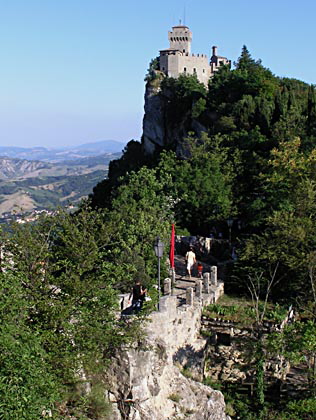|
For our purposes here, we define Central Italy as the areas of Perugia, Marche and Lazio, except for Rome which has its own page. We came to these areas in early summer, 2005. We had just left the Milan area where it was quite warm and oppressively humid, so we were glad when it appeared these areas were at least a bit less humid.
|
|
Our first objective was to visit the independent republic of San Marino, near the east coast of Italy. The main tourist area of San Marino is the hilltop where the fortresses are, so that is where we headed. The city sits at the very top of a rocky crag, with 3 defensive towers (the second tower shown in the photo at left). Walking around the area is difficult as it is all up or down hill. However, there are fantastic views from the top. Although San Marino has a lower tax base than Italy, it doesn’t advertise itself as a “duty free” zone as does Livigno or Andorra (in Spain). However, we did find some relief when we purchased gasoline for the bike as it was significantly less than in Italy.
|
|
|
Perugia was our next stop as we headed into the central hills of Italy. Perugia is a hilltop town that has a huge central piazza with cathedral, fountain, and palace (photo right). Perhaps it was because we came in the afternoon (when most people rest in the heat of the day) but we found the place a bit characterless, although the architecture is certainly beautiful. We tried to visit the Palazzo, but it never opened according to the hours listed on the door.
|
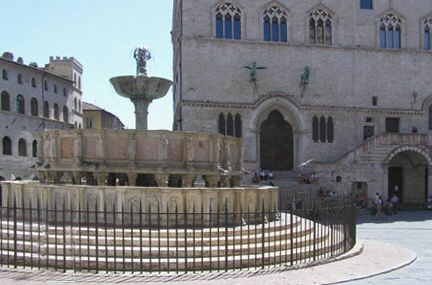
|
|
|
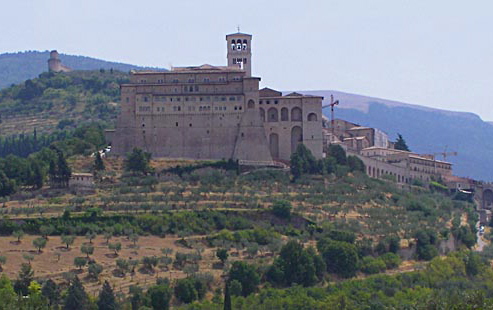
|
We then headed to Assisi, home of Saint Francis, patron saint of San Francisco. The photo at left is a view of Assisi as it sits upon the hill. Assisi is much smaller than Perugia, but appeared to a bit more “alive.” The church of St. Francis is huge and beautiful, but no photos were allowed inside. We found the central square to be interesting as it had a church on the square that was formerly a Roman temple to Minerva. It was a strange view to be looking at this obvious temple with columns at the front and seeing the Christian cross. Early recycling.
|
|
|
Here we take a slight detour to the mountains to the Parco Nationale del Monti Sibillini and the Gran Sasso. Verna had read about a small mountain village where a good Pecorino cheese is made. On the way there, much to our delight, we discovered the Gran Piano, a huge, high plain spectacularly situated at the mountain top (photo right). And yes, we found the pecorino at the village of Castelluccio, along with many sheep grazing on the plain. We then drove the western side of the Gran Sasso. A lovely place to go riding.
|
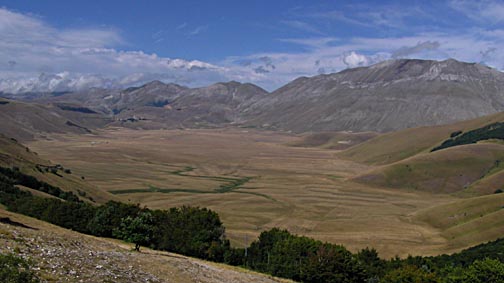
|
|
|
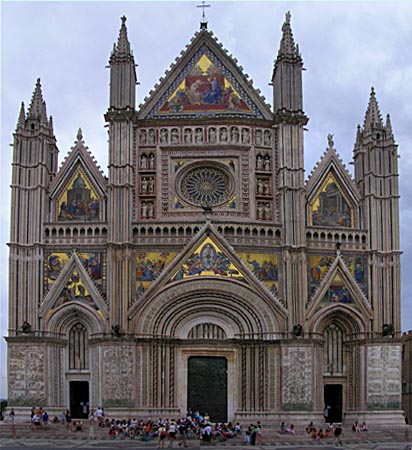
|
Then to Orvieto, which like Assisi, seemed quite vibrant. The Duomo there was certainly a sight to behold with the golden mosaics adorning the front facade (photo left). Inside, it was much more sedate with the alternating bands of black and white marble providing the architectural focus.
Viterbo was our next stop, a huge walled city. The old medieval quarter was the highlight here, perfectly preserved in a quiet part of the city. Arched walkways and uniform use of stone made it a pleasing place to visit. The modern Viterbo is vibrant and full of pedestrianized shopping streets. Everyone appeared to be out enjoying the warm weather (or perhaps just trying to avoid their hot houses).
|
|
|
Near the coast, we stopped at the town of Tarquina, first to visit the Etruscan museum, full of sarcophagi and pottery, mostly found in the tombs which we later visited. The Etruscans were an early civilization to this area and were later dominated by the Romans (about 200 BC). Since the Romans settled in the Etruscan areas, not much is known about how they lived, though it is believed that they left their influence on the Roman way of life. The photo above is of one of the many tombs found nearby.
|
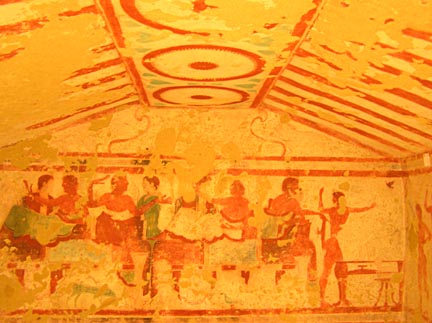
|
|
|
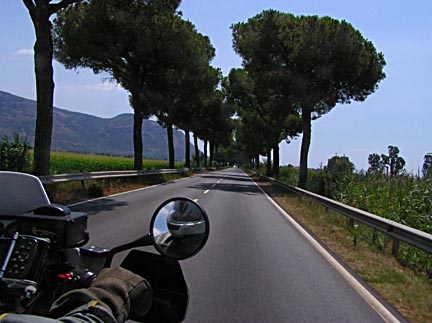
|
Leaving Rome, we traveled part way on the infamous Appian Way, one of the first roads to be made in a straight line. As you can see from the photo at left, nothing has changed.
We made a brief stop in Cassino where the Monastery of Monte Cassino sits high on the hilltop. This was a strategic position in WWII because of the commanding view all the way to the coast. In a few short hours, the monastery was practically leveled. The cemetery there attests to the lives lost during the battle. After the war, the monastery was completely rebuilt using the original plans and financed by the Italian government. Today it is a beautiful sight.
Click here to view a slide show of additional photos from Central Italy.
|
|
|

